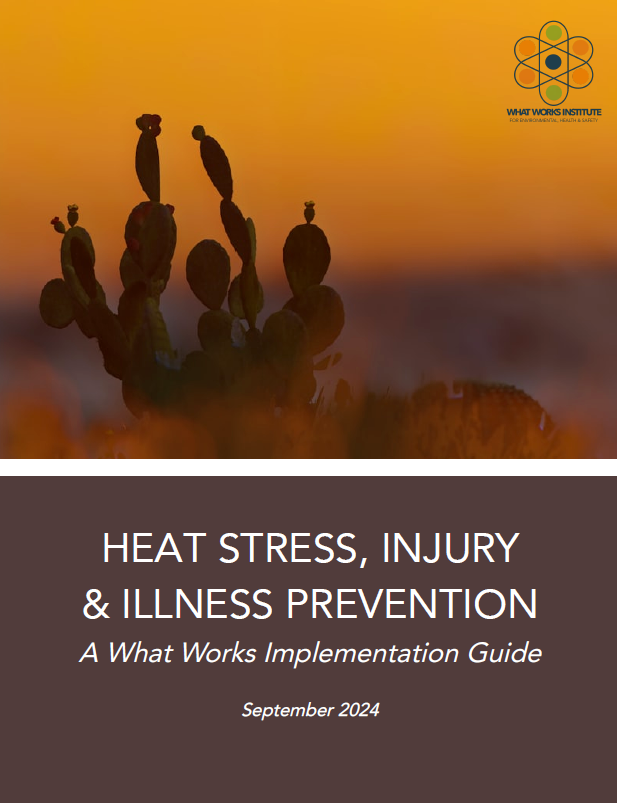What Works Implementation Guide: Heat Stress, Injury & Illness Prevention
A comprehensive guide to compliance, policies, programs and best practices related to heat injury and illness prevention.
Table of Contents:
Background & Context
1.1 Introduction to Heat Stress
1.2 Significance for Corporate EHS Leaders
Broader Climate & Heat Stress Dynamics
2.1 Climate Change and Increasing Temperatures
2.2 Scientific Basis of Heat Stress
Current Conditions & Environmental Challenges
3.1 Overview of Present-Day Conditions
3.2 Sector-Specific Vulnerabilities
Evolving Regulatory Landscape
4.1 Global Regulatory Trends and Movements
4.2 Current Regulatory & Practice Landscape (Federal & California)
Strategic Maturity Model & Self-Assessment
5.1 Maturity Model Overview:
5.2 Diagnostic Tool: Organizational Self Assessment
5.3 Implementation Tool: Risk Assessment and Prioritization
Policy & Program Toolkit
6.1 Policy Development & Sample Policy Statement
6.2 Program Guidance & Sample Program Template
Strategic Considerations & Sample Implementation Materials
7.1 Decision Points & Corner Cases
7.2 Practical Rollout Tools
Continuous Improvement
8.1 Stakeholder Engagement
8.2 Ongoing Education & Training
8.3 Efficacy Assessment
Conclusion & Next Steps
9.1 Summary of Key Takeaways
9.2 Action Plan for Organizations
9.3 Future Considerations
References & Works Cited
A comprehensive guide to compliance, policies, programs and best practices related to heat injury and illness prevention.
Table of Contents:
Background & Context
1.1 Introduction to Heat Stress
1.2 Significance for Corporate EHS Leaders
Broader Climate & Heat Stress Dynamics
2.1 Climate Change and Increasing Temperatures
2.2 Scientific Basis of Heat Stress
Current Conditions & Environmental Challenges
3.1 Overview of Present-Day Conditions
3.2 Sector-Specific Vulnerabilities
Evolving Regulatory Landscape
4.1 Global Regulatory Trends and Movements
4.2 Current Regulatory & Practice Landscape (Federal & California)
Strategic Maturity Model & Self-Assessment
5.1 Maturity Model Overview:
5.2 Diagnostic Tool: Organizational Self Assessment
5.3 Implementation Tool: Risk Assessment and Prioritization
Policy & Program Toolkit
6.1 Policy Development & Sample Policy Statement
6.2 Program Guidance & Sample Program Template
Strategic Considerations & Sample Implementation Materials
7.1 Decision Points & Corner Cases
7.2 Practical Rollout Tools
Continuous Improvement
8.1 Stakeholder Engagement
8.2 Ongoing Education & Training
8.3 Efficacy Assessment
Conclusion & Next Steps
9.1 Summary of Key Takeaways
9.2 Action Plan for Organizations
9.3 Future Considerations
References & Works Cited
A comprehensive guide to compliance, policies, programs and best practices related to heat injury and illness prevention.
Table of Contents:
Background & Context
1.1 Introduction to Heat Stress
1.2 Significance for Corporate EHS Leaders
Broader Climate & Heat Stress Dynamics
2.1 Climate Change and Increasing Temperatures
2.2 Scientific Basis of Heat Stress
Current Conditions & Environmental Challenges
3.1 Overview of Present-Day Conditions
3.2 Sector-Specific Vulnerabilities
Evolving Regulatory Landscape
4.1 Global Regulatory Trends and Movements
4.2 Current Regulatory & Practice Landscape (Federal & California)
Strategic Maturity Model & Self-Assessment
5.1 Maturity Model Overview:
5.2 Diagnostic Tool: Organizational Self Assessment
5.3 Implementation Tool: Risk Assessment and Prioritization
Policy & Program Toolkit
6.1 Policy Development & Sample Policy Statement
6.2 Program Guidance & Sample Program Template
Strategic Considerations & Sample Implementation Materials
7.1 Decision Points & Corner Cases
7.2 Practical Rollout Tools
Continuous Improvement
8.1 Stakeholder Engagement
8.2 Ongoing Education & Training
8.3 Efficacy Assessment
Conclusion & Next Steps
9.1 Summary of Key Takeaways
9.2 Action Plan for Organizations
9.3 Future Considerations
References & Works Cited




